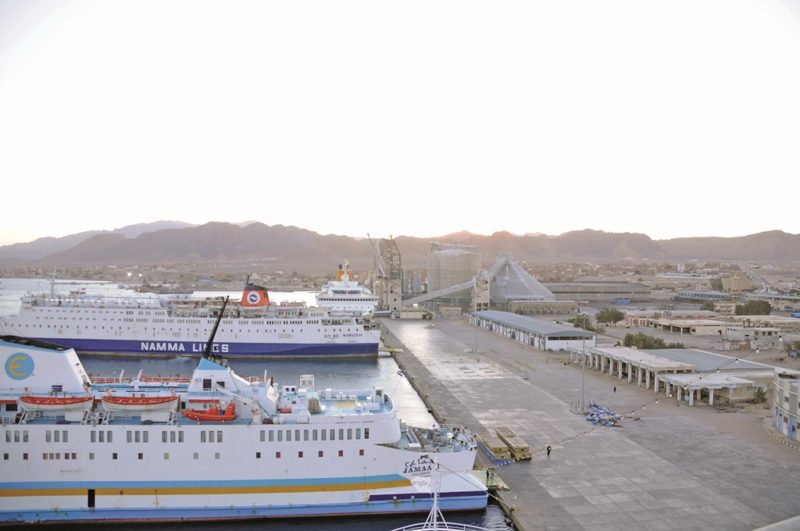
Safaga is Arabic for ‘hot dusty winds’ that frequently blow up the Red Sea and stir up the black or yellow sand dune beaches. It is a ‘rough and ready’ industrial and ferry town with a port sheltered by an offshore island measuring eight kilometres long and 3.5 kilometres wide at its widest point. The view from the Port Harbour Office is of this offshore Safaga Island, with the approach channel to the port used by ships only in daylight when the coastal reefs are clearly visible with the Light House at a distance of 1.6 miles on the southern coastal headland of Safaga Island. Safaga Island is a restricted military zone and not accessible to tourists.
The Port of Safaga is administered by the Red Sea Port Authority of Egypt, which also administers the Ports of Suez, Hurghada, Sharm El Sheikh and Nuweiba. Safaga is located 33 miles south of Hurghada and 110 miles south of Suez, with Nuweiba on the west side of the Gulf of Aqaba, and Sharm El Sheikh at the entrance to the Gulf of Aqaba. The Port of Safaga has important exports of phosphates, and imports of alumina, wheat, cement, project cargo and general cargo. The port is also an important ferry port for travellers to Duba, Yanbu and Jeddah in Saudi Arabia. Most readers will remember Safaga as the port that Michael Palin was delayed by a day or two when his booked ferry to Jeddah was cancelled due to engine trouble. He then missed a sea connection from Jeddah to the Persian Gulf, and he was forced to drive himself without the camera crew on the hot roads across Saudi Arabia via Riyadh to catch a dhow at Dubai to continue his ‘Around the World in Eighty Days’
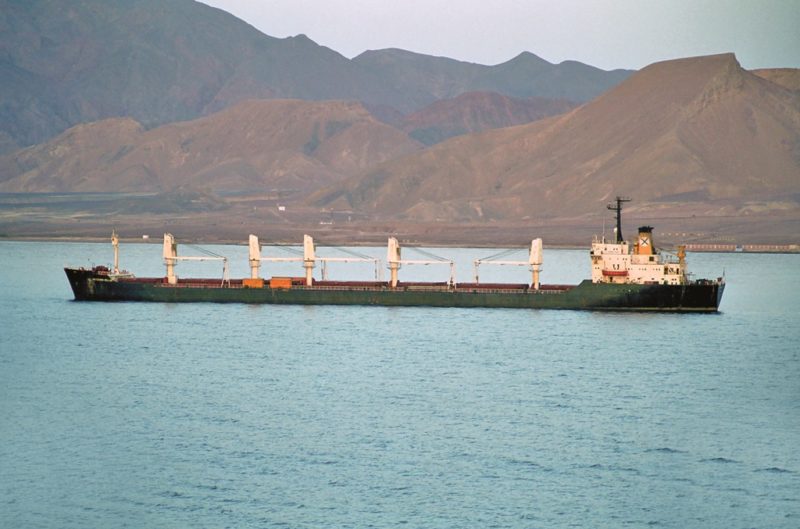
HISTORY OF SAFAGA
The Greek historian Herodotus said that Egypt was ‘the gift of the Nile Valley’ as the fertile irrigated valley has 99% of the population of Egypt on only 4% of the land area of Egypt. Pharaoh Sahure used Safaga as a base for exploration and trade in the Red Sea over 4,000 years ago. Since then, volcanic activity has been slowly widening the Red Sea, to an amount of around 300 feet in 4,000 years. At the southern end of the Red Sea at the very narrow sea gap of Bab al Mandab, volcanic activity associated with the tectonic plates at the north end of the Great Rift Valley are pulling Egypt and Saudi Arabia apart. Three new volcanic islands of several hundred feet in height have been created in the Zubair archipelago recently in 2007, 2011 and 2013 to the north of the Bab al Mandab.
The Port of Safaga lies on the coastal Red Sea with a population of only 38,000 and lies in the Eastern Desert of Egypt, which rises steeply from the Nile valley to a bare, broken plateau, and then slopes upwards to a high mountain range, the Red Sea Hills rising to 7,150 feet in height, which border the Red Sea. The Western Desert of Egypt lies to the west of the Nile valley and is larger than the Eastern Desert at around 240,000 square miles, and contains several oases and large scoured depressions e.g. the Qattara depression which is 436 feet below sea level. The Nile runs for 746 miles from the Aswan High Dam in the south to the Mediterranean delta, with two main branches at Damietta and Rosetta, with large quantities of cotton grown in the delta.
The Port of Safaga lies on the arc of a wide bay sheltered by Safaga Island. It has large imports of alumina for transfer to the MISR Aluminium Company plant on the banks of the Nile in Southern Egypt. Electricity is needed in large quantities to smelt aluminium from the turbines of the Aswan High Dam, with the first pot line opened in 1975 of 92 cells, which has risen to a current six pot lines of 552 cells to give a production of 320,000 tonnes of aluminium per year. Aluminium ingots, slabs, billets, coils, wire and bars are then exported.
The construction of the Aswan High Dam began in 1960 with a loan of Soviet finance of $1.12 billion at 2% interest and was completed ten years later in 1970. The Russian President Nikita Kruschev and President Nasser of Egypt attended a special ceremony on 14th May 1964 when the Nile was diverted away from its channel to begin the construction of the dam, which is the largest embankment dam in the world. Safaga is considered as one of the oldest ports in Egypt, beginning with the export of phosphate ores in 1911 from this Red Sea port. The port is an important phosphates export centre, with numerous phosphate mines nearby, and the paved A60 road of 102 miles to Qena in Upper Egypt to reach many more phosphate mines. It served a useful purpose for the Allies in World War II, and is also a focal base and point for the Egyptian Navy to carry out the tasks in securing the east side of Egypt since the devastating Arab/Israeli Wars of the 1960s and 1970s.
Islamic pilgrims for Jeddah to see and worship at the Great Mosques of Mecca sail from Safaga, with the ferry port having room for six ferries at any one time, all moored stern first in the usual ‘Mediterranean Moor’ style to the quay. Ferries also leave for Duba and Yanbu in Saudi Arabia, as well as international trade to Sudan and other African countries and to ports in South East Asia and Australia. The new Ferry Terminal 3 has been built at Safaga close to the Port Headquarter Office with construction costing £15 million and was ongoing from 2007. Safaga is the main port for the Upper Egypt region, with a growing international cruise ship clientele, who undertake the three and one half hour hot coach trip on the A60 road to visit the Temple of Karnak, the Temple of Hatshepsut, the Valley of the Kings, and the Valley of the Queens. The Temple of Karnak at Luxor is a vast site consisting of three main temples, several smaller enclosed temples, and a number of outer temples. This site was built over a period of 1,300 years before Christ and includes some of the finest examples of ancient Egyptian design and architecture.
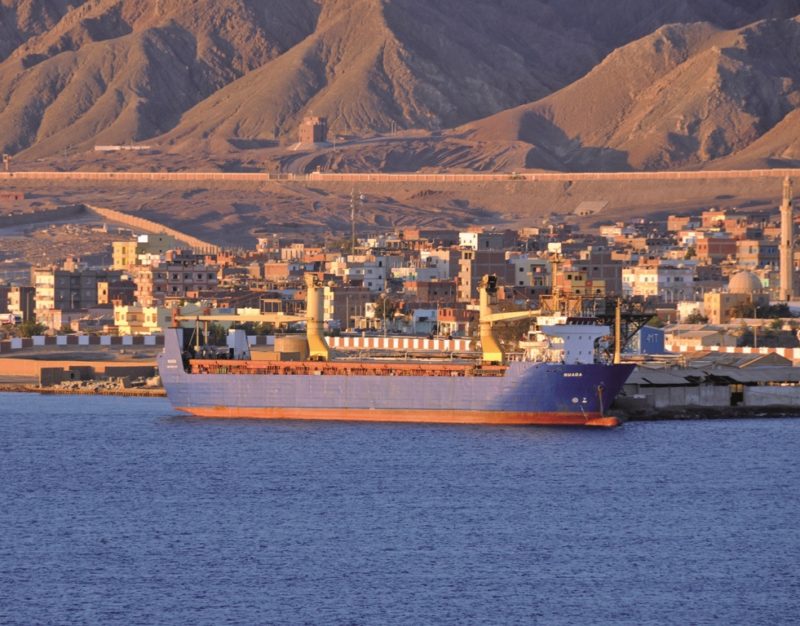
The tombs of the Valley of the Kings were stripped of their contents several centuries ago, but still contain beautiful paintings depicting the lives of the Pharaohs, and of course the tomb of the boy king Tutankhamun was only discovered by Howard Carter in 1922, with his gold and blue face mask brought to London in 1973 for an important exhibition. The most famous tomb in the Valley of the Queens is that of Nefertiti, the principal wife of Ramses II, which was only opened to the public in 1995. Queen Hatshepsut was the first woman ever to reign over Egypt as a Pharaoh, and her temple was built by the architect Senenmut. The ships of Queen Hatshepsut c1500 BC arrived in Red Sea ports from expeditions to present day Indonesia with spices, used in food preservation, medicine, cosmetics and dyeing. There are also important Islamic and Christian monuments close to Safaga.
Safaga was founded between 282 BC and 268 BC by Satyrus, a Greek explorer who called it Philotera in honour of the deceased sister Philadelphus of Pharaoh Ptolemy II. Safaga is considered to be a therapeutic health centre for tourists, with the Safaga Hotel, Lotus Bay Hotel, and Safaga Sharms Resort near glorious sandy beaches, scuba diving and coastal boat trips, proving the health benefits. Safaga was the host of the 1993 Red Sea Windsurfing Championship, and has been a port for merchant shipping for many centuries. The climate of the port is classed as a hot desert climate with the highest ever recorded temperature in summer of 46 degrees Centigrade, with an average July temperature of 35 degrees Centigrade, and only one rainy day in the entire year in winter. The town parks have specially planted trees that can withstand the hot climate, with yuccas, aloe vera, cordylines, phormiums and spiky ichmea plants growing in most locations. The prevailing winds come from the inland mountains, but the port is also exposed for a short period of the year to the southerly Azib wind, which causes large waves and turbulence inside the port area from both northwest and southeast directions.
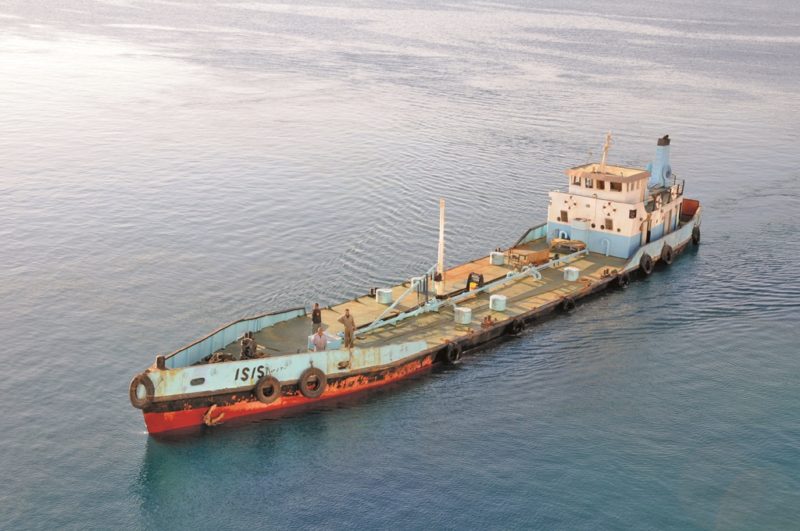
THE PORT OF SAFAGA
All shipping should only begin their approach to the port in the early morning and maintain a distance of 925 metres from clearly marked coral reefs when taking their course to the port from the south in line with two towers on the mainland. Really huge fines are imposed by the Egyptian Government on any vessel that damages the pristine and precious coral reefs. Pilotage is compulsory with pilots boarding vessels at the inner end of the AIS entrance channel using VHF radio and Satnav aids to navigation. The port limitations for vessels are a maximum deadweight of 75,000 dwt (Panamax size), maximum length overall of 290 metres and a maximum draft of 12.8 metres. The port is situated between Hamrawein to the south and Hurghada to the north, and is thus a deep water port sheltered by its own island and coral reefs. Yearly traffic figures are around 740 ship calls per year, with a throughput tonnage of between 3.9 and 4.2 million tonnes of cargo per year, as well as around 880,000 ferry and cruise passengers per year. The maximum port capacity is for 4.2 million tonnes of dry bulk, and 2.2 million tonnes of general cargo, giving a total of 6.4 million tonnes of cargo.
The port is located at position 26°44′ North, 33°57′ East and is two hours ahead of Greenwich Mean Time. The port has a water area of 56km2, and a land area of 1km2. The berths for ferries and cruise ships are Berths 2 and 3 out of a total of six berths, with four cargo berths to the side of these ferry berths. The Port Berths are as follows:-
BERTH 1 – Dry Bulk import berth of overall length 290 metres and alongside depth of 10 metres for grain, wheat, iron ore and cement
BERTHS 2 & 3 – Ferry and general cargo berths of overall length 440 metres and alongside depth of 14 metres
BERTH 4 – Alumina import berth of overall length 282 metres and alongside depth of 10 metres
BERTH 5 – Mineral phosphate export berth of overall length 260 metres and alongside depth of 14 metres for phosphates from Abu Tartour mine
BERTH 6 – Mineral cargo berth of 156 metres overall length and alongside depth of 8 metres for the export of phosphates
The anchorage has a depth of 17.1 to 18.2 metres within the shelter of Safaga Island, and the total quay length of the port is thus 1,428 metres. The port has open storage yards of ten asphalt paved yards, twelve soil foundation yards without paving, and one dirt yard. The total area of these 23 yards is 160,700m2, with the MISR Aluminium Company silos and stores at another 129,700m2, and grain silos of 16,579m2, to give a total port area of 146,279m2. There are port gates for the Alumina berth, Emergency gates 1 and 2, Railroad entry and exit gates with two powerful locomotives owned by the port, entrance to the new passenger terminal, truck entry and exit gates, and the port administrative office. All of the port buildings are very modern, especially the entrances and large indoor areas of the new and spacious Ferry Terminal 3. Hurghada airport is only 55 kilometres away, and the port facilities include solar electricity, diesel oil, lubricating oil, light and heavy fuel oil, fresh water, machine and tool accessory aids, with navigating charts and nautical publications for sale. A cleaning fee of 5% for dirty water reception is charged for all types of ships, and the port has good fire fighting facilities, medical facilities, security and communications with Suez Port Radio Station. The tidal range of the port is between 1.2 metres and 2.1 metres.
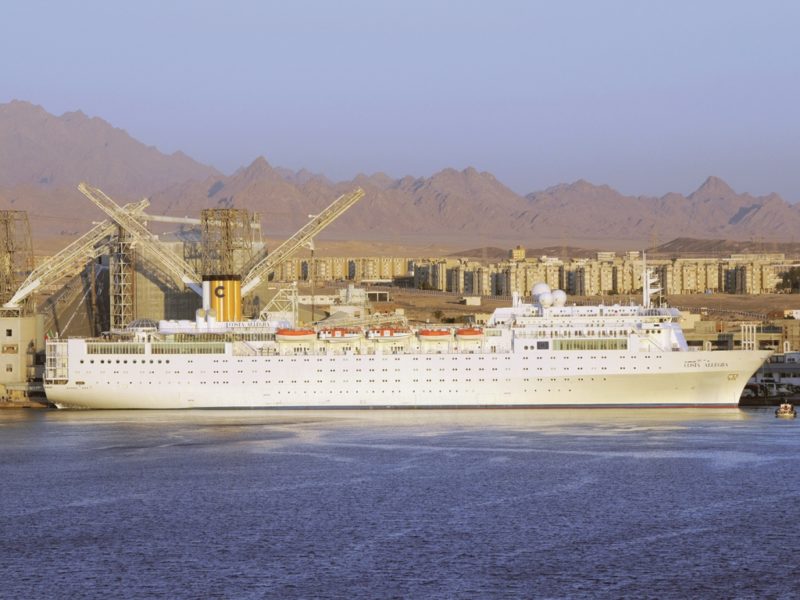
SAFAGA PHOSPHATES TRADE
Good quality rock phosphates were discovered at Esna in 1960 in the Nile valley, and were initially exploited by Russian mining companies using electricity generated by the turbines of the Aswan High Dam, again financed by Russian credit. The first cargoes of rock phosphates were then exported from Safaga to Poland, Hungary, Bulgaria and other Eastern bloc countries. In 1960, Florida was the biggest producer of rock phosphates in the world, followed by Morocco and Egypt in that order, but subsequently Morocco became the largest producer followed by Egypt in second place.
The EL NASR Company mines rock phosphates in the Eastern desert, while the PHOSPHATE MISR Company mines rock phosphates in the Western desert. The EL NASR Company produced 4.2 million tonnes of rock phosphates in 2011, while the joint production of both Egyptian Government owned mining companies in 2015 was 6.0 million tonnes. Egypt was seventh of the top ten rock phosphates producers in the world. Ismail Mahmoud founded the Al Madina Contracting Company (MCC) in the early 1990s to service both of the two State owned mining companies, and carries out the drilling, extraction, crushing, transport and worldwide sale of the product. Specialist explosives and Caterpillar draglines and excavators, and large heavy rock breakers from the South Korean Soosan Heavy Industries are used to blast and move the rock phosphates out of these big area mines. All worldwide importers of Egyptian rock phosphates sign long term contracts with the Egyptian Government.
The MCC company had also carried out the Cairo Subway Project of 1991 to 1995, and the Toshki Canal Project between 1997 and 2000. MCC supplies rock phosphate cargoes in the range from 5,000 tonnes to 100,000 tonnes, with small phosphate samples sent out by air to prospective customers throughout the world. High quality diphosphorus pentoxide (P2O5) is the salt of phosphate that the Egyptians mine, there are also several other types of phosphates mined elsewhere in the world, with Egyptian high quality phosphates having as high as 30% pure phosphate or as low as 22% of pure phosphate. The MCC company has a Head Office in Nehro Street in Heliopolis in the capital of Cairo, and state that the Sebaya mines in the Eastern and Western deserts and the Abu Tartour mines in the Western desert contain the highest quality rock phosphates grades.
Global phosphates consumption for the manufacture of fertilisers was 48 million tonnes in 2020. The Egyptian rock phosphates are shipped from the four Red Sea ports of:-
SAFAGA using ship loaders and conveyor belt systems positioned on quays
HAMRAWEIN using long angled booms to gain height for the conveyor belts to drop phosphate vertically into the holds of bulkers moored fore and aft to offshore pontoons
ADABIA and AIN SOKHNA, both located just to the south of the Port of Suez using conventional conveyor belt loading.
The Panamax bulk carrier Esna of 71,600 dwt, owned by NNC of Egypt, loaded phosphates at Safaga between 13th and 22nd February 2021, while the smaller Turkish bulker Fuat Bey of 35,500 dwt loaded phosphates at a nearby phosphate berth. These bulkers are loaded down to the Tropical Load Line, as their destinations were Tuticorin and Western India ports for discharge. Planned export cargoes of phosphate rock fines in later February 2021 from Safaga were 20,000 tonnes for Tuticorin, 65,000 tonnes in two cargoes for Western India ports including Hazira in Gujarat, and 25,000 tonnes for Eastern Indian ports. In return, 30,600 tonnes of calcined alumina (aluminium oxide) of purity greater than 96%, is received monthly from Vizagapatnam in India in a balanced trade to the benefit of both Egypt and India. The coast roads of Al Gomhoreya and Al Sharki provide good vantage points for seeing the bulkers exporting rock phosphates, and the bulkers importing alumina.
The Safaga Maritime Port is expanding with larger quantities of their main two cargoes of export phosphates and import alumina. The Egyptian Government announced in the summer of 2018 that it was funding new multi million dollar phosphate mines in the Aswan High Dam area, and also expanding the Port of Safaga, a major hub for agribusiness exports to India. Two new phosphate mines had come onstream since 2015, with eight more phosphate mines planned in either the Western or Eastern desert areas.
The Egyptian aluminium smelter at Nag Hammadi was commissioned in the mid 1970s at a production capacity of 100,000 tonnes per year. Expansion took place in 2007 to increase production to 280,000 tonnes (2008), 300,000 tonnes (2009) and 320,000 tonnes (2010). Aluminium is produced in the forms of ingots, bars, sheet, coil, foil, cable, wire, and extruded products. Egypt also has large deposits of kaolins in the Red Sea coast and Sinai areas, and at Kalabsha near the Aswan High Dam, and it may be possible to use this hard form of kaolin for the production of paper and ceramics in the future. Iron ore for the big steel smelter at Beni Suef 65 miles south of Cairo arrives in bulkers such as Eastern Hawk of 37,250 dwt, which arrived from Port Hedland in Western Australia on 23rd February 2021. There are also Egyptian steel smelters at Port Said and Alexandria with total Egyptian steel production of 1.48 million tonnes of steel bars and billets per year.
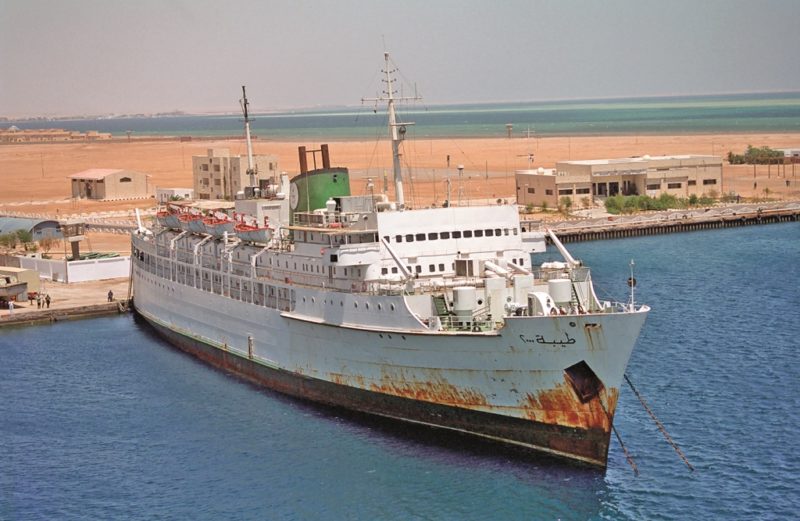
SAFAGA FERRY LINES – NAMMA FERRY LINE
This line is the most frequent user of the Port of Safaga, often using two or more of the six ferry berths. It is part of the Nesma Holdings Co. Ltd., a leading Saudi Arabian transport group, including Namma International Marines Services Co. Ltd. and Namma Ferry Lines. The ferry line was formed in 2005 with only one ferry operating at first between Safaga and Jeddah, and the fleet has since grown into four passenger ferries and two ro-ro freight ferries. The fleet now serves the three ports of Duba, Yanbu and Jeddah in Saudi Arabia, where they are the official ferry agents, and one port of Sawakin in Soudan. The ferries have ‘NAMMA LINES’ in white bold capitals on both sides of their black hulls, with red funnels carrying the company logo. The company has carried over 200,000 passengers in the last decade, particularly pilgrims to Jeddah for the Haj and Umrah acts of devotion at Mecca, and has won awards from Jeddah Islamic Port and the Sudan Ministry of Transport. The company works with eight partners in the hotel, transportation and maritime industries to provide seamless services for all of the needs of their passengers.
The NAMMA ferry Line fleet in recent years has been as follows:-
Ro-pax Amanah of 19,909 grt built in 1979 as Emilia for Tirrenia di Navigazione and renamed Adriatica in 2006. She was purchased by NAMMA in 2014 under the name of Al Yosefeyah and carries up to 2,000 passengers, 470 cars and has a crew of 98. She serves the Safaga to Yanbu route on Tuesdays and Wednesdays each week.
Ro-pax Masarrah of 11,495 grt built at Aalborg in April 1977 as St. Columba for Sealink (U.K.) with accommodation for up to 1,400 passengers, 335 cars, and a crew of 99. She has one main restaurant, and two main lounges, all three each seating 150 passengers, and a smaller lounge seating fifty passengers, as well as a self service buffet. She was purchased in 2007 by NAMMA and is registered at Jeddah along with the rest of the fleet.
Ro-pax Mawaddah of 16,961 grt built in Kanasashi in Japan in 1972 as Erimo Maru and purchased from Minoan Lines of Greece as King Minos in 2005. She has accommodation for 1,500 passengers and 300 cars on her car deck, and with a crew of 99. She has 141 First Cass cabins, 63 Second Class chairs, and a dozen Pullman sets, with a main restaurant, a self service buffet, and three spacious lounges seating up to 371 passengers. The hot summer climate of the Red Sea had many passengers using her Al Jazira swimming pool. On 27th January 2019 she arrived at Gadani Beach to be broken up.
Ro-pax Mahabbah of 14,707 grt built at Hashihama in Japan in 1972 as Cassiopeia and purchased in 2006 for the route between Safaga and Jeddah taking 35 hours for the voyage, and booked to capacity during the busy Haj and Umrah pilgrim periods. She has accommodation for 1,000 passengers, 350 cars on her car deck, and a crew of 90. She has two restaurants and two self service buffets, and sails to Jeddah on Wednesdays and Thursdays, and to Yanbu on Mondays and Tuesdays.
Freight ro-ro Namma Express of 9,088 grt was built in 1985 as Balder Sten for Norwegian owners, and has since had several names until purchased in 2012. She has a lane length of 1,224 metres for all types of trucks, trailers and ro-ro cargo, whether break bulk, bulk or refrigerated, all loaded down to her maximum draft of 5.3 metres. Overnight cabins for 38 drivers are provided.
Freight ro-ro Alnawa Express of 10,035 grt was built at Dalian in 1990 as Eglantine for Cobelfret of Belgium and running into the Thames on short voyages. She was purchased in 2013 with a lane length of 1,604 metres for all types of ro-ro cargo, all loaded down to her maximum draft of 5.33 metres. Overnight cabins for 26 drivers are provided.
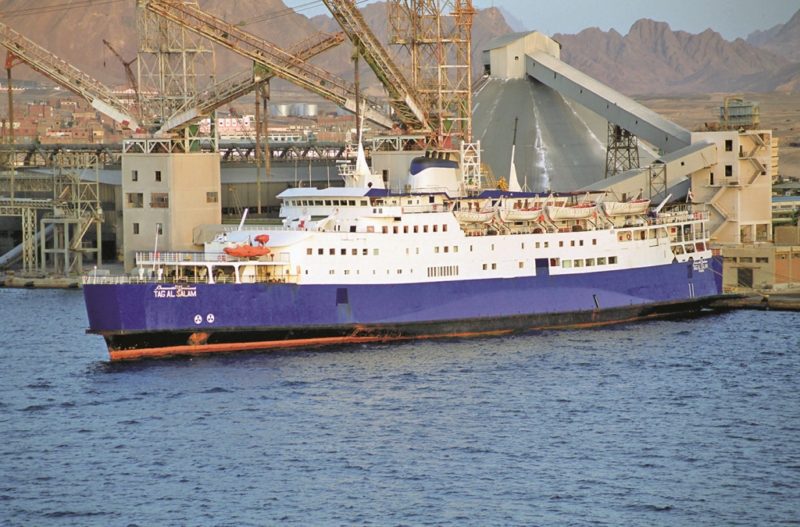
ARAB BRIDGE MARITIME – (AB MARITIME)
This line runs passenger ferries across the Upper Red Sea with also a freight route from Safaga to Duba. It was founded in November 1995 under a Maritime Co-operation Convention by the Governments of Jordan, Egypt and Iran to connect commercial ferry routes between their countries in the Red Sea, with the paid-up share capital of $6 million equally shared between the three Governments. The company name is an appropriate name as ferries are in fact ‘Sea Bridges’. The Head Office is in Aqaba with branch offices in Amman, Cairo, Teheran and elsewhere in the Arab world. Arab Bridge Maritime owns 50% of the Arab Ship Management Company of Jordan and 30% of the Jordan Academy for Maritime Studies. The company operates two routes across the head of the Gulf of Aqaba, with a daily fast high speed craft passenger service taking one hour from Aqaba to Taba near the Israeli border at Eilat, and a daily slow passenger ferry taking 2.5 hours from Aqaba to Nuweiba in Egypt, as well as a twice daily freight only ro-ro heavily loaded with trucks and trailers.

Chartered ferries were used at first by the company, but now it owns seven ferries with three high speed craft in Queen Nefertiti of 3,971 grt and built in 1997 with seats for 580 passengers and room for 170 cars on the car deck, and The Princess of 2,552 grt and built in 2003 with seats for 654 passengers and room for 58 cars on the car deck, and the newest fast craft Babel purpose built for the company in Australia with seats for 217 passengers. Two of the fast craft trio operate from the Port of Aqaba to Taba in Egypt near Eilat in Israel. There are three traditional passenger ferries and two freight ro-ros in the fleet with white funnels with an ‘AB’ logo and a black top named:-
Sinaa of 9,667 grt and built in 1995 with seats for 350 passengers and room for 380 cars on the car deck, and is the former Volcan de Tejeda of Armas Ferries in the Canary Islands, her present name is that of the Sinai peninsula.
Aylah of 5,119 grt and built in 2009 with seats for 960 passengers and room for 90 cars on the car deck, and is the former Thassos VIII ferry operating in Greek waters.
Amman of 8,851 grt and built in 1995 with seats for 811 passengers and room for 440 cars on the car deck, and is the former Manuel Azana of Balearia Line operating in the Western Mediterranean between Spanish ports and the Balearic Islands, and Ceuta and Melilla in North Africa.
Freight ro-ro Amal of 14,938 grt and built in 1993 by Fincantieri as Via Mediterraneo for Viamare di Navegazione. She has 1,830 metres lane length for lorries on the Safaga to Duba route with accommodation for fifty drivers, with a service speed of 19 knots, and was purchased in 2020 by AB Maritime.
Freight ro-ro Bridge of 7,363 grt built in 1995 and purchased in 2008 with capacity for 60 trucks on two decks, with an internal ramp fitted in February 2016 to replace an internal elevator to enable her to make two freight trips per day on the Aqaba to Nuweiba route. She is the former Egizia of Adriatica Line of Italy, her name meaning ‘Egyptian’.
The twin funnelled ferry Pella of 10,675 grt was built in 1983 by Kochi Heavy Industries in Japan as Bizan Maru, and later sailed for ANEK Lines as Arkadi. She was purchased by AB MARITIME in 2002 and renamed Pella. She sailed from Aqaba on 3rd November 2011 for the Egyptian port of Nuweiba but caught fire only 15 miles from the port. All of her 1,200 passengers were safely evacuated and rescued with only one person lost, and the smoking wreck lingered afloat for another four days before sinking only ten miles from Aqaba.
The AB MARITIME passenger ferries all have white hulls with the company logo emblazoned in big letters on each side, and are equipped with bow and stern ramps, with the comfortable lounge shop and café supplied with pure drinking water from a desalination plant built at Nuweiba for the ferries and the local population. There is also an Arab Bridge Maritime passenger service from the popular beach resort of Sharm El Sheikh on the southern Egyptian tip of the Sinai Peninsula to Hurghada on the Egyptian Red Sea coast using the Queen Nefertiti fast ferry on twice weekly trips taking 2.5 hours each way. A total of around 1.5 million ferry passengers plus around 150,000 cruise passengers use the Port of Aqaba per annum.
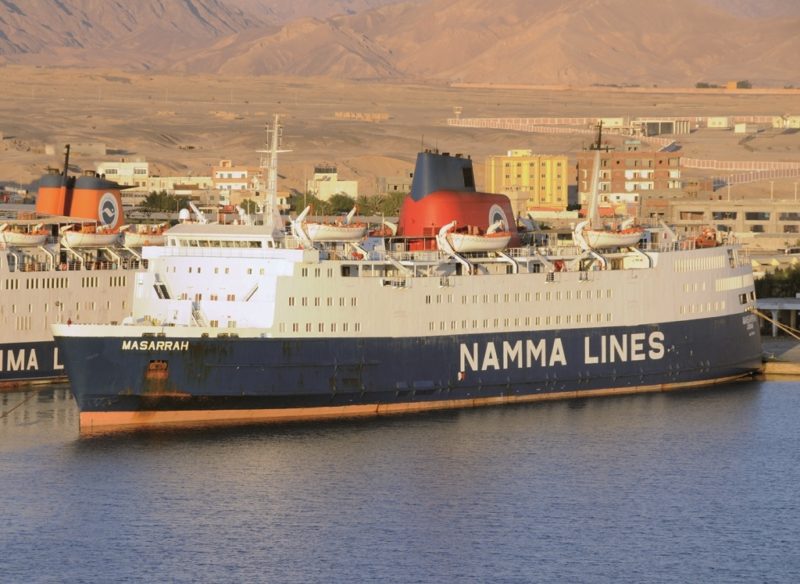
EL SALEM MARITIME
The ferry Boccacio was a member of the ‘Poeta’ class of eight 22 knot passenger and ro-ro ferries delivered to Tirrenia of Italy in 1970/71. Five of this class were in service for almost thirty years until the advent of high speed ‘super’ ferries.
Initially, a class of six vessels named after writers entered service as Boccaccio (completed first on 8th June 1970), Carducci, Leopardi, Manzoni, Petrarca and Pascoli, with a further two units following in 1978 named Deledda and Verga. They were used on the longer routes to Sardinia, Sicily, Tunisia and the island nation of Malta. They had accommodation for 1,000 passengers in three class together with 125 cars or trailers. This proved insufficient to meet the growing need for passengers taking their cars on holiday, and five of the class were rebuilt in 1990, with four decks added to give a bizarre and top heavy appearance.
Boccaccio, Carducci, Manzoni, Petrarca and Pascoli had their gross tonnage increased from 6,900 to 11,779, and this quintet continued in service until sold in 1999. This technique of adding several more decks as well as side sponsons was not unique to Tirrenia, as P. & O. Ferries of the U.K. also gave the same treatment to some of their English Channel and North Sea ferries.
Some of the sextet were sold to El Salem Maritime for service in the Red Sea, and Petrarca under the name of Al Salam Petrarca 90 sailed from Duba for Safaga on 22nd June 2002. Unfortunately, a fire broke out shortly after leaving port, and all passengers were evacuated before she sank, with only eleven injuries reported.
Boccaccio unfortunately capsized after catching fire on 3rd February 2006 while on a voyage from Duba in Saudi Arabia to Safaga in Egypt with the loss of 1,012 passengers and crew under the name of Al Salam Boccaccio 98. The owner of the ferry, El Salem Maritime, gave orders to continue with the voyage instead of returning to port as her Master had requested. She was carrying 1,400 passengers and 96 crew, with only 314 survivors rescued by Egyptian frigates, and a further eight survivors were picked up by Italian patrol vessels after searching for over ninety hours. After this second disaster, the three remaining ‘Poeta’ class sisters owned by El Salem Maritime were sold for breaking up in India.
El Salem Maritime used a total of 21 ferries during the 21 years from 1990 to 2011, when it ceased trading, most of the fleet lasting only a short duration with the company.
European ferries that served included the former Townsend Thoresen ferries Viking Valiant and Viking Venturer, built in 1972 and 1973, that were sold to El Salem Maritime and renamed Pride of Al Salam 1 and Pride of Al Salam 2 respectively in 2002. Free Enterprise VI, built in 1972, was sold to El Salem Maritime in 1996 and renamed Pride of Al Salam 95. She collided with the cargo ship Jebel Ali in the Red Sea on 17th October 2005 and sank while on a voyage from Suez to Jeddah, two people lost their lives unfortunately.
The French SNCM ferry Chantilly of 5,691 grt built in 1966 at Nantes became Alam Salam 93 with accommodation for 1,350 passengers and 190 cars, while Deutschland of 6,118 grt built at Rendsburg in 1972 became Al Salam 97 in 1998, but only lasted a year in the fleet.

UNITED MARINE EGYPT (UME)
This ferry line is the most recent to begin operations in the Upper Red Sea, with the large, twin funnelled freight ro-pax Poseidon Express, formerly Translubeca pf 24,727 grt. She was built in 1990 by Stocznia Gdynia for Baltic services of Finnlines to Germany, with a lane length of 2,100 metres for 185 trucks and trailers and 300 TEU of containers on four decks, and accommodation for 84 drivers. She was purchased by Greek owners in October 2013 for charter work in the Eastern Mediterranean, and was recently purchased by UME running from Safaga to Duba in Saudi Arabia. She has a service speed of 20.5 knots from powerful twin Wartsila Sulzer diesel engines and is the flagship of the fleet.
The other UME ro-pax is Duba Bridge of 16,537 grt, built in 1976 by the New South Wales Dockyard at Newcastle and used on the Safaga to Duba route after purchase by UME in 2019. She is of 16,527 grt with a lane length of 1,055 metres for freight, and also carries 361 passengers.
There are two other vessels in the fleet, both freight ro-ros in Elgouna Trader, built in 1987 of 7,095 grt with a freight capacity of 900 trucks and trailers, and is named after the resort El Gouna to the north of Hurghada.
The second freight ro-ro is Gubal Trader of 7,616 grt built in 1979 at Falkenberg in Sweden as Gute for Rederi A/B Gotland to serve the Swedish island of Gotland. She has a lane length of 969 metres for lorries and trailers and accommodation for 86 drivers and was purchased by UME in 2020.
SAFAGA FAST CRAFT and OTHER FERRIES
Safaga has a fast craft service to Duba in Saudi Arabia run by Al Kahera Ferries (KCFMT) using two express fast ferries Al Kahera (Cairo in Arabic) and Al Riyadh built in 2008 by Austal Ships at Fremantle in Australia. KCFMT was established on 4th January 2009 to operate this pair for the Egyptian Government. They have aluminium double hulls and are powered by four diesel engines of 28,800 bhp via powerful water jets to give a service speed of 34 knots and a voyage time of three hours between Safaga and Duba, timed exactly with stern doors open in three hours on reaching berth. The Head Office of KCFMT is in Safaga, with a branch office in Alexandria. The Port of Safaga received 121,000 tonnes of medical liquid oxygen on fast ferry Al Riyadh for Egyptian hospitals from Saudi Arabia during 2020, part of which was used to help the breathing and the fight for life of seriously ill Covid-19 patients. Freight traffic on the Safaga to Duba route was up 33% for the year of 2020.
Namma Line used two fast craft between 2006 and 2010 in Red Sea 1 and Red Sea 2, purchased as Aeolos Kenteris and Panaghia Parou respectively.
The ‘Papenburg Sister’ Diana of 6,850 grt was built in 1972 for Viking Line services in the Baltic, and after four changes of name, she was purchased in September 2006 for a scheduled service from Safaga to Jeddah under the name of Rahal. She arrived at Alang on 16th March 2021 to be broken up and was beached twelve days later.
The twin grey hulled sisters, Al Hurreya and Al Hurreya 2 of 6,542 grt and 6,000 dwt, are used by the Egyptian military on various duties, and commercially on the Safaga to Duba route. These ro-ros have a strong gated stern ramp for the loading and carriage of tanks and heavy military equipment, and were built by the Alexandria Shipyard in 2005 and 2007. They are operated by Triumph Shipping of Cairo, which was founded in 2009 by the Egyptian Armed Forces and Minister of Defence to create a military transport facility. They also operate on commercial ro-ro services when not required by the military. They operate from military storage yards in Port Tewfik and Alexandria, with Al Hurreya used to transport Egyptian armed forces to participate in the ‘Raad Al Shamal’ joint exercise with Saudi Arabian armed forces in February 2016. The sisters were represented at the EDEX (Egypt Defence Expo) event in December 2018 for showcasing military equipment.
The well known Belfast ferry Ulster Queen was built in 1967 by Cammell, Laird & Co. Ltd. for the Belfast Steamship Co. Ltd., the service from Liverpool being taken over by P&O in 1971. After closure of the route in 1981, Ulster Queen was sold for Mediterranean service as Med Sea, Al Kahera and Ala-Eddin. She joined Hellenic Mediterranean Lines of Greece in 1988 as Poseidonia, and then in 2005 arrived in the Red Sea as a pilgrim ferry under the name of Al Kahfain. She sailed from Hurghada on 22nd November 2005 for Jeddah with only her crew onboard as she was to pick up returning pilgrims at Jeddah. She rounded Shedwan Island and then suffered an engine room explosion and fire that quickly spread through the ship. The crew abandoned ship and she later capsized at the end of the night with 58 survivors although one crew member unfortunately died. She lies on the seabed off Safaga resting on her starboard side.
The ferry El Tor of 4,609 grt was built in 1981 by Bergens Mek Verft for the Misr Edco Shipping Company of Alexandria with accommodation for 1,025 passengers, 150 cars on her car deck, and a service speed of 19 knots. She was named El Arish by El Salam Maritime in 1991, and was later in 1999 running for Sayed Nasr Navigation Lines of Egypt between Safaga and Jeddah in 1999. She sailed on her final voyage from Jeddah to Safaga in 2001 when she suffered a bad fire in the engine room, and she then lay at anchor off Safaga for five years and became a local landmark for the fishermen and tour operators until she suddenly sank in 2006 without anyone witnessing her demise.
The ferry Salem Express of 4,771 grt was wrecked on the Hyndman Reef on 15th December 1991 around six miles off Safaga after making an unlawful deviation of course while approaching the port from Jeddah. She was built as Fred Scamaroni in June 1966 at La Seyne for CGT of France for the route between Marseille and Ajaccio on Corsica. She had near sisters in Corse and Comte de Nice, also completed in 1966 but at St. Nazaire. This trio had overall lengths of 377.3 feet, moulded beam of 59 feet, with a loaded draft of 16 feet. They were twin screw powered by twin eight cylinder Pielstick diesel engines of 14,880 bhp to give service speeds of 20.5 knots. They had accommodation for 1,420 passengers with 394 in First Class cabins, 240 in Second Class cabins, and 520 deck passengers with a crew of 64. Fred Scamaroni was transferred to SNCM of France in 1976, and sold in May 1980 to begin a new service between Ramsgate and Dunkirk operated three times daily by Dunkerque Ramsgate Ferries S. A. under the name of Nuit Saint Georges.
Unfortunately, a French fishing fleet strike blocked Dunkirk harbour after only four months of operation, and she was laid up at Flushing until sold in July 1982 to become Lord Sinai for Lord Maritime Enterprises of Alexandria. She was renamed Al Tahra in 1984 and Salem Express in 1990 for El Salam Maritime.
She sailed from Jeddah on her last fateful 450 mile voyage from Jeddah to Safaga, taking 36 hours, and then would have continued north to Suez on her usual run. A storm was raging when she ran aground on the Hyndman Reef at 2313 hours, ripping a hole in the starboard bow and knocked open the forward ramp door with the car deck then quickly filling with seawater. She sank in 20 minutes, and Lloyd’s Marine Casualties states that her Master took a short cut that was not authorised for night passages, with only 180 survivors out of a total of 644 passengers and crew. Many passengers were trapped in their cabins as the wreck plunged to the seabed at a depth of 32 metres, with only 117 bodies recovered from this dreadful and unnecessary disaster.
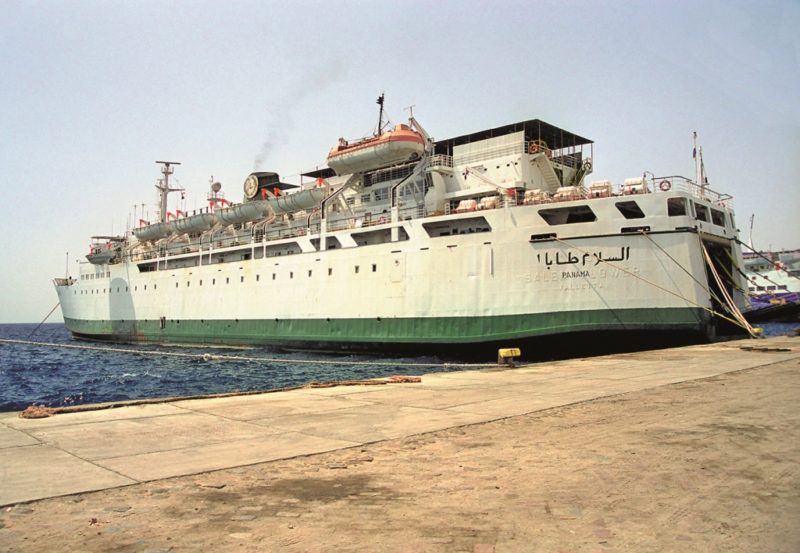
NATIONAL NAVIGATION COMPANY (NNC)
This shipping company was established by the Egyptian Government in 1981 to develop a national commercial fleet under the name of the MISR Shipping Company of Alexandria (MISR means Egypt in Arabic). It has a paid up capital of $US50 million, and has developed into the largest Egyptian shipping company with a fleet of a dozen dry bulkers, a container ship, a passenger ferry, and five general cargo ships to operate on liner and chartered general cargo services to Northern Europe, the Adriatic, Black Sea and Mediterranean countries.
In 1985, six bulkers were purchased, four of 45,000 dwt and two of 32,000 dwt, and in the 1990s the quartet was replaced by another quartet of Panamax bulkers of 71,500 dwt, as well as a container ship of 3,000 TEU capacity, the first in the Egyptian fleet, named Al Albaya.
The six bulkers in 1998 were named Abydos, Aton, Esna, Edfu, Saqqara and Thebes. The MISR Shipping Company was renamed in 2003 as the National Navigation Company (NNC) to give a national identity to the fleet.
Two more Panamax bulkers were added, as well as two general cargo ships of 12,000 dwt, and a passenger ferry with accommodation for 1,000 passengers.
The latter was built in 1987 as Sharm el Sheikh with dimensions of overall length 118.4 metres, moulded beam of 17.9 metres, and a loaded draft of 5.5 metres. She is of 9,042 grt with a service speed of 17 knots, and was sold to MISR Shipping in June 1994 to undergo a three month refit into a pilgrim ferry by the Neptun Warnowwerft yard at Rostock, emerging as Dahab in September 1994. She now has twin green funnels with an Arabic logo, and sails from Port Sudan with pilgrims. She is named after a town located 53 miles north of Sharm el Sheikh on the Gulf of Aqaba.
In 2005, 70% control of the freight forwarder Egyptian Shipping Transport, founded in 1957, was obtained, as well as 90% control of the shipping company Egyptian Navigation Company founded in 1961. A large investment of $US445 million was made in 2009 in six more bulkers, and a move was made to begin petroleum, oils and gas shipments with the establishment of the National Company for Shipping Petroleum, the first Egyptian oil shipping company.
The current fleet is under the management of a Chairman and eight directors to expand the range of shipping activities, as well as to keep transport control of Egyptian phosphate exports and alumina imports. The fleet of a dozen big bulkers of between 57,320 dwt and 80,500 dwt have been built by Hitachi in Japan, STX Shipbuilding Company and Daewoo Heavy Industries in South Korea, and are named Esna, Edfu, Wadi Safaga, Wadi Alarab, Wadi Alarish, Wadi Albostan, Wadi Alkarm, Wadi Alkarnak, Wadi Alyarmouk, Wadi Feran, Wadi Sudr, and Wadi Tiba. The fleet have blue hulls with white funnels carrying an Arabic logo.
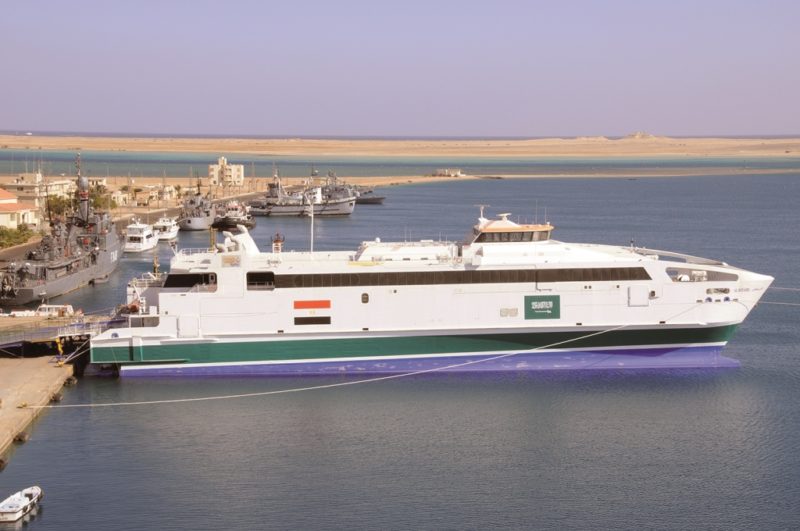
POSTSCRIPT
The Covid-19 virus crisis stopped all ferry sailings from Safaga to Duba, Yanbu and Jeddah in March 2020. Maritime Transport Sector (MTS) Minister of Transport, Lieut General Kamel, directed the leaders of the Red Sea Ports Authority to raise the levels of readiness and take all necessary steps to facilitate the return of Egyptian citizens from the Saudi Arabian port of Duba. After passenger movement was stopped due to precautionary measures taken by both sides to prevent the spread of the Covid-19 virus, dozens of Egyptian citizens were stranded for over three weeks at the port gates of Duba, until agreeing to a 14 day quarantine on arrival at Safaga on a specially organised ferry sailing on 30th April 2020. The ferry Al Kahera (Cairo) arrived at Safaga with 283 Egyptian passengers and 66 cars on 13th June 2020, with rapid virus testing before and after arrival of passengers, port workers wearing full masks and protective clothing, and the ship being sterilized after arrival.
Egyptian Minister Kamel Al-Wazir announced on 22nd January 2020 a massive investment of £500 million in a new container and general cargo berth to be built 6 kilometres south of the Port of Safaga. The container storage and general cargo areas will be of 750,000m2 and the length of the container ship berth will be 1,000 metres. Safaga is of much importance in the Red Sea to East Coast of Africa trade, and is also the main port serving the Upper Governates of North, Central and South regions (known as the ‘Golden Triangle’) of the Upper Nile. The development axis of this area will be greatly benefited by this new container berth for industry, logistics and storage of containers and general cargo destined for the development of the Upper Nile.
The Port of Safaga is an expanding port with the lighthouse at the southern end of Safaga Island administered by the Egyptian Ports and Light Houses Administration (EPLA). This authority is based at Alexandria and was founded in 1830 when an assembly body was appointed to supervise the construction of the port to receive vessels through an opening in two breakwaters into the Port of Alexandria. It today operates from Alexandria as the Egyptian Authority for Maritime Safety (EAFMS) with an excellent website at www.mts.gov.eg/en. The authority has carried out harbour works, salvage work, lighthouse development, and installation, improvements and maintenance to navigation aids in the harbours and along the coasts of Egypt and particularly the Red Sea ports.





Comments
Sorry, comments are closed for this item